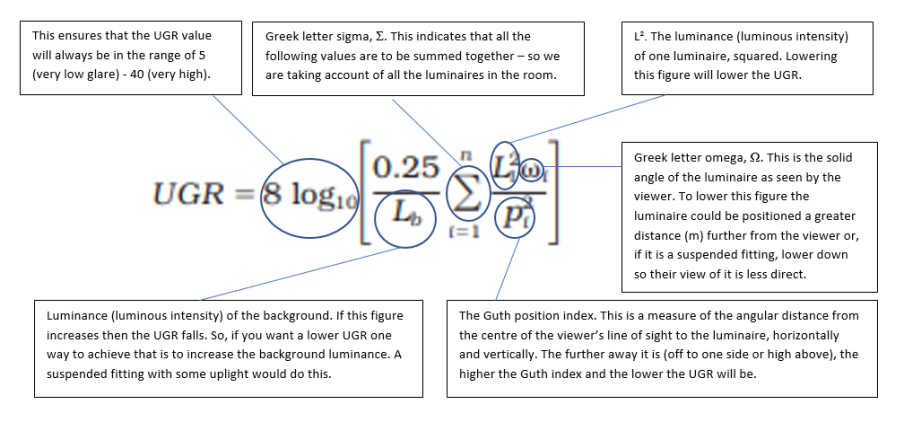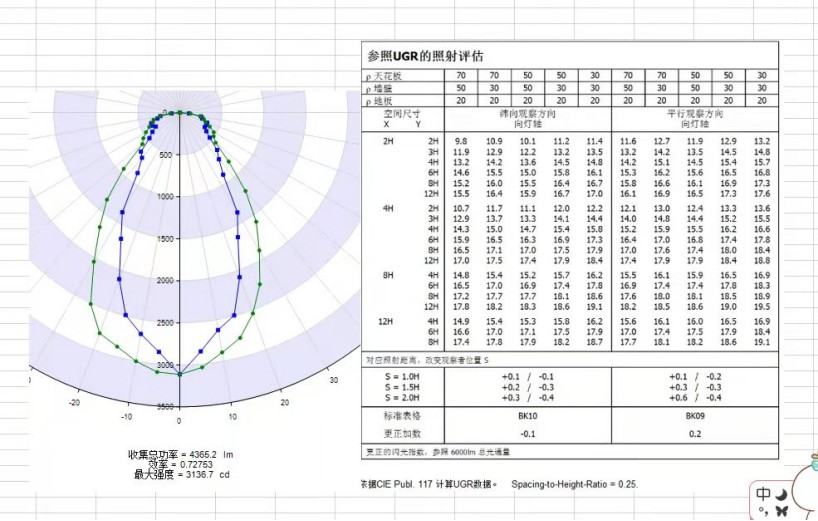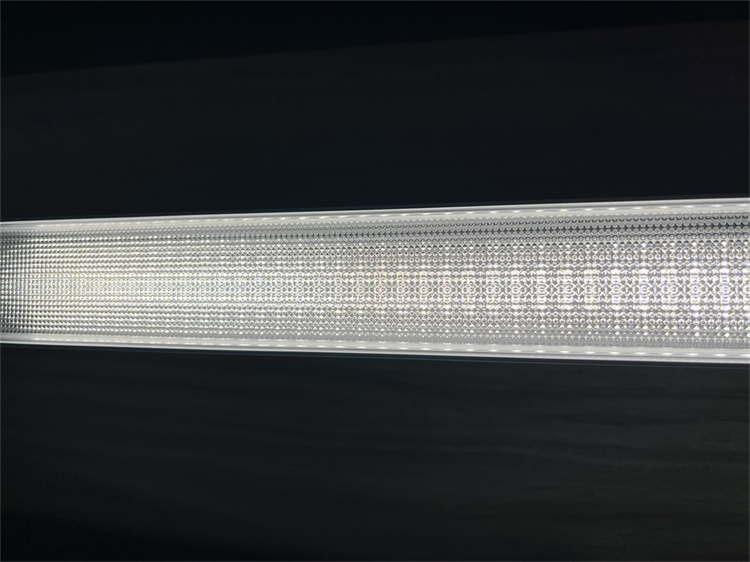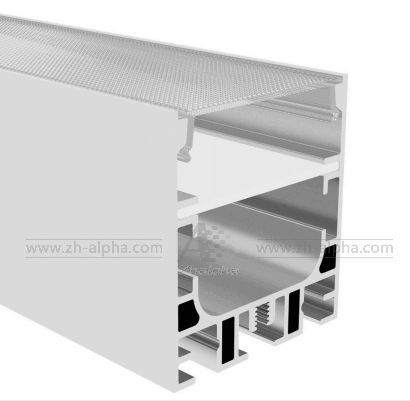With the increasing popularity of minimalist design, linear lighting are used in many places such as offices, supermarkets, hotels, schools, etc. Nowadays, users have higher and higher requirements for the lighting fixtures, who wants more light output with smooth beam blends, and low UGR. So, today we will see what is UGR and explore how to effectively reduce the UGR of linear lights.
1. What is UGR
UGR is an expression of the relative intensity of light from a luminaire compared to the intensity of light from the surrounding area as perceived by the viewer. UGR can only be calculated for interior lighting installations, not for exterior installations (such as street lighting), and not for luminaires alone.
The following formulas are used to calculate UGR. By following these instructions, you will have a clearer understanding of this important measure of lighting installation quality.

Calculating the UGR is actually not as complicated as it may seem and can be easily done for each project with widely used lighting design programs such as Relux, Dialux and AGi32. All you need to do is enter a luminosity file that includes the luminaires used in the lighting plan, the room dimensions, the surface reflectance, and the number and spacing of the luminaires. The aforementioned lighting design software will calculate the UGR based on these data.
2. Why is UGR important?
UGR stands for Uniform Glare Rating. It is an objective measure of glare that is used by lighting designers to help control the risk of artificial lighting glare to building occupants, and UGR values range from 40 (very high glare) to 5 (very low glare). In most cases, less glare is better, so low UGR is preferable to high UGR. International standards such as EN12464 recommend maximum UGR for different situations. For many office and classroom environments, UGR <19 is recommended. UGR is measured for the installation, not for the luminaire. However, the design of a luminaire can have a significant impact on the UGR of the installation in which it is used.
3. What is UGR<19 luminaire
Strictly speaking, there is no such thing. The UGR relates to the installation, not the luminaire. However, many manufacturers sell luminaires that are described as "UGR<19"-what does that mean? It means that the light distribution of the luminaire will help the lighting designer provide a UGR <19 installation if the luminaire is used at typical heights and spacings in the intended environment. Therefore, there is no guarantee that using a "UGR<19" fixture in an office or classroom (for example) will result in a UGR <19 installation, but choosing a fixture with the proper lighting distribution will improve your chances.
4. UGR requirements for different locations
BS EN12464 Lighting and illumination - lighting in the workplace, recommends maximum UGR levels for different applications. In summary, the standard lists more than 280 different types of work areas in almost all types of work environments, from classrooms, offices and hospital wards to indoor parking lots and industrial premises. Please check more details in UGR levels for different interior areas
5.How to reduce UGR of installation
Below are several steps you can take during the design and installation process to reduce UGR.
(1) Consider the position of the occupants of the room relative to the location of the luminaire. For example, if the layout of the classroom is known, place the lights out of the line of sight of the students looking toward the teacher.
(2) Consider the choice of luminaire:
If suspended, can it be suspended at a lower height?
Can you introduce an uplight component? Projecting light onto the ceiling will reduce the contrast between the luminaire and the background, thus reducing the UGR.
For ceiling mounted luminaire, choose luminaire with narrower beam angles. This will reduce the luminous intensity perceived by the viewer. Be careful - this may reduce uniformity, so consider reducing wattage and adding more luminaire to offset this.
Consider using luminaire where the light source or light emitting surface (such as the diffuser) is recessed behind a bezel.
In summary, to reduce UGR, you need to
Increase the background luminance
Reduce the luminance of the luminaires which seen by the viewer (narrow the beam angle or decrease the wattage)
Angle the luminaire away from the viewer so they are not shining in their eyes
Avoid placing the luminaires in the direct line of site of the viewer
6.How to reduce UGR for luminaire?
From the UGR calculation formula and the solution to reduce the installation UGR, we could know that the following three factors affecting the luminaire UGR:
Luminance
Luminous area
Beam angle
The earliest UGR <19 luminaire on the market is LED panel lights, and its solution is to place the LED on the frame side, and use a guide plate to guide the lights to the diffusion plate. This solution is for the luminaire with 600 * 600mm luminous area, 36W, luminous efficacy of 100lm / W, then the UGR< 19. Referring to this mature solution, if we want to reduce the UGR of the linear light, to make the UGR lower, we must control the luminous beam angle between 65°-85° and make the luminous efficiency 90-110lm/W under a certain luminous area.
In order to meet the UGR requirements of customers who is manufacturing Led linear light fixture for office application, Alpha has developed a glare control solution, which is with a anti-glare micro-prismatic lens, please check the following design data and lighting performance.


Transparent micro-prismatic lens reduce the glare value of the luminaire through horizontal and vertical precise light control at the same time, so as to achieve the purpose of anti-glare. We are now have 30+ models available for different application with width 30-180mm, please contact us for more details.



 简体中文
简体中文
